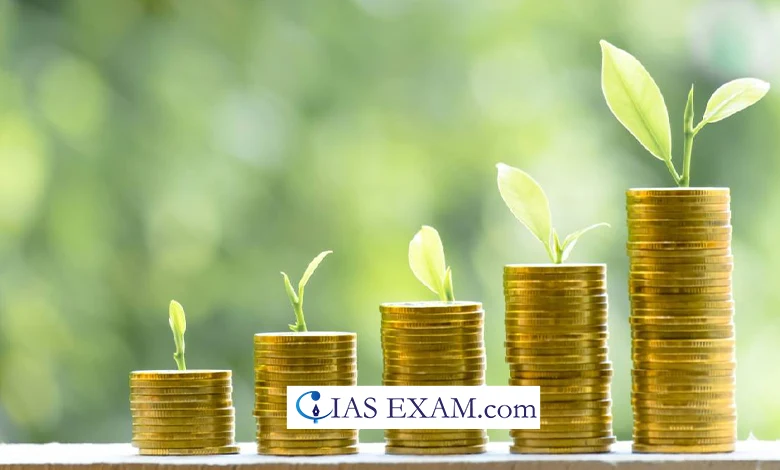Daily Current Affairs for UPSC
Sovereign Green Bonds (SGrBs) of India
Syllabus- Economy [GS Paper-3]

Context
The Reserve Bank of India (RBI) green has recently highlighted investments in the country’s Sovereign Green Bonds (SGrBs) by Foreign Institutional Investors (FIIS).
Foreign Institutional Investors (FIIs)
- Foreign Institutional Investors (FIIs) are companies or entities that make investments within the financial markets of a country other than their own.
- These traders can encompass pension funds, mutual funds, insurance groups, banks, and different massive financial institutions from overseas countries.
- FIIs play a widespread function in the financial markets of a country by imparting liquidity, increasing trading volumes, and influencing stock expenses.
- They spend money on a range of financial units, which include shares, bonds, and derivatives, based on their investment techniques and market outlook.
- The inflow of funds from FIIs could have both positive and negative effects on the local financial system, depending on various factors which include market situations, government policies, and global financial traits.
- Investments by FIIs in India are regulated by the Securities and Exchange Board of India (SEBI) at the same time as the ceilings on such investments are maintained by the Reserve Bank of India (RBI).
Green Bonds
-
- Green bonds are issued by companies, countries and multilateral firms to completely fund initiatives that have advantageous environmental or climate benefits and provide traders with constant income payments.
- The tasks can encompass renewable energy, easy transportation and green homes, amongst others.
- Example of Green Bonds:
-
- The World Bank is a primary provider of green bonds and issued $14.4 billion of green bonds between 2008 and 2020.
- These bonds were used to assist 111 projects around the world, in large part in renewable energy and performance (33%), easy transportation (27%), and agriculture and land use (15%).
- By the end of 2020, 24 national governments had issued Sovereign Green, Social and Sustainability bonds totalling a cumulative $111 billion.
India’s Sovereign Green Bonds Framework
- First introduced in the Union Budget 2022-23, the proceeds of those green bonds might be issued for mobilising resources for green infrastructure.
- Aim –
- To mobilise Rs 16,000 crore through the issuance of green bonds in the current fiscal ending March 2023.
- Under the framework, the Finance Ministry will, every year, inform the RBI about spending on green initiatives for which the fund raised through these bonds will be used.
Features of the SGrBs
- Issuance Method
-
-
- SGrBs will be issued through Uniform Price Auction.
- Eligibility for Repurchase Transactions (Repo)
- SGrBs can be eligible for Repurchase Transactions (Repo).
- SGrBs may also be reckoned as eligible funding for Statutory Liquidity Ratio (SLR) cause.
-
- Tradability
-
- SGrBs might be eligible for trading in the secondary market.
- Investment by Non-residents
- SGrBs may be designated as unique securities underneath the ‘Fully Accessible Route’ for investment in Government Securities by non-residents.
Eligible Projects
-
- All eligible green bonds will encompass public expenditure undertaken by the government in the shape of investment, subsidies, grants-in-useful resources, or tax foregone (or an aggregate of all or some of those) or choose operational costs.
- R&D bonds in public sector projects that assist in reducing the carbon depth of the financial system and enable the country to fulfill its Sustainable Development Goals (SDGs) are also included in the framework.
- The eligible bonds could be restricted to government costs that happened most one year prior to issuance of the green bonds.
- Sectors not include
-
- Nuclear energy technology, landfill initiatives, alcohol/weapons/tobacco/gaming/palm oil industries and hydropower plants larger than 25 MW were excluded from the framework.
FIIs to Invest in Green Bonds
- The Reserve Bank of India (RBI) has accepted investments in the country’s Sovereign Green Bonds (SGrBs) by Foreign Institutional Investors (FIIS).
- The RBI had issued SGrBs worth ₹16,000 crore in two tranches in January and February last year with maturities in 2028 and 2033.
- While in both times the bonds were oversubscribed, the primary participants were domestic financial institutions and banks, narrowing the avenues from which the government ought to borrow.
- SGrBs yield lower interest than conventional G-Secs, and the quantity foregone by using a bank by making an investment in them is called a ‘greenium’.
- But central banks and governments internationally are encouraging financial institutions to embody greeniums to hasten the transition to a greener future.
Significance of the RBI’s Decision
- Allowing FIIs to spend money on India’s green initiatives widens the pool of capital available to fund the country’s following bold dreams pledged by the Prime Minister at COP26 in Glasgow 2021:
- 2070 net zero goals,
- Ensuring 50% of India’s energy comes from non-fossil gas based sources and
- To reduce the carbon intensity of the state’s financial system by 45%.
Source: The Hindu
UPSC Mains Practice Question
Q.With reference to ‘IFC Masala Bonds’, sometimes seen in the news, which of the statements given below is/ are correct? (2016)
- The International Finance Corporation, which offers these bonds, is an arm of the World Bank.
- They are the rupee-denominated bonds and are a source of debt financing for the public and private sector.
Select the correct answer using the code given below:
(a) 1 only (b) 2 only
(c) Both 1 and 2 (d) Neither 1 nor 2
Ans: (c)





.png)



